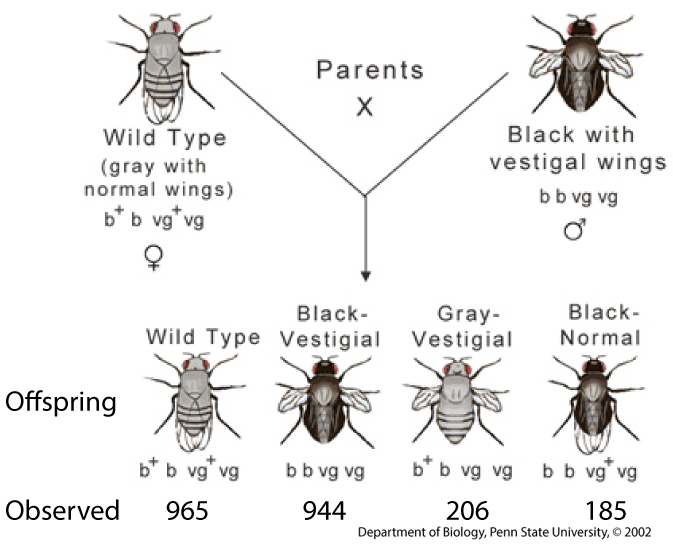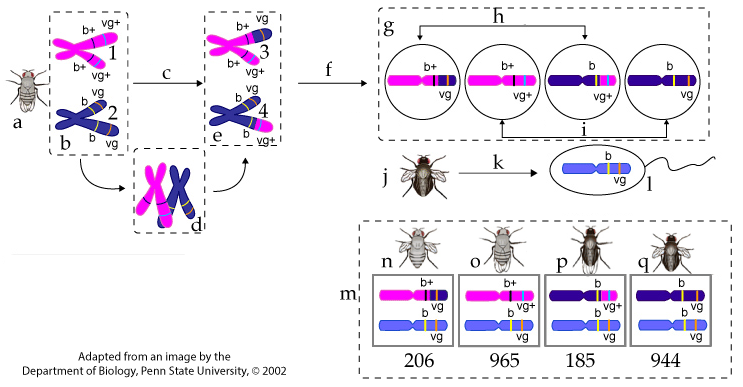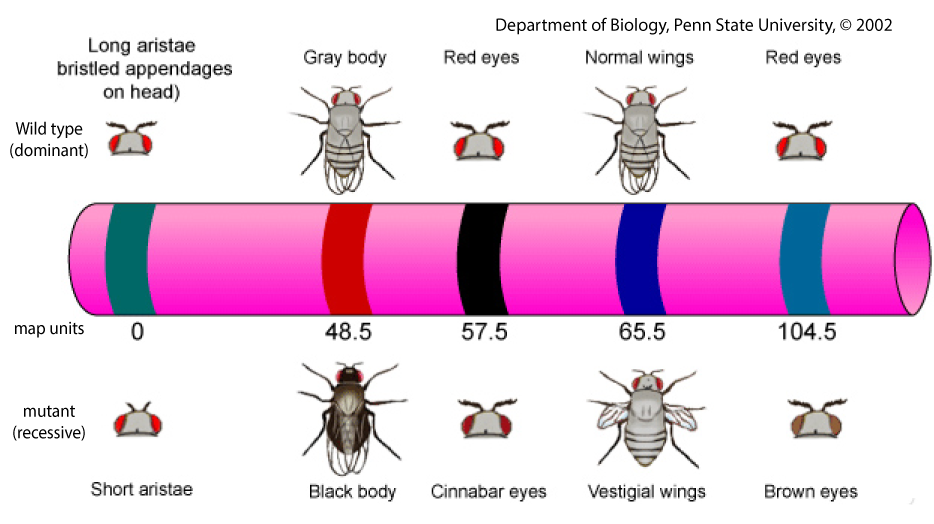1. Watch this video
2. Study this summary
1. Linked Genes and Their Inheritance Patterns
- Linked Genes: Genes located on the same chromosome. Unlike independently assorting genes in Mendelian genetics, linked genes are often inherited together.
- Representation: Wild-type (dominant) alleles are denoted with a “+” sign (e.g., “b+” for normal body color). Recessive alleles lack the “+” (e.g., “b” for black body color). Note that genes can also be represented by two letters: “vg+” for normal wings, “vg” for vestigial wings.
2. Test Crosses and Results
- Test Cross: A dihybrid individual (e.g., b+b vg+vg, gray body and normal wings) is crossed with a double recessive individual (e.g., bb vg vg, black body and vestigial wings).
- What you’d expect if there were no recombination: Offspring would show a 1:1 ratio of parental phenotypes (e.g., gray body with normal wings and black body with vestigial wings).
- Actual Results: While most offspring display parental phenotypes, a significant minority exhibit recombinant phenotypes (e.g., gray body with vestigial wings or black body with normal wings). These recombinant offspring (as explained below) are the result of crossing over during meiosis.

3. Recombination and Crossing Over
- Cause of Recombinants: During meiosis, homologous chromosomes exchange segments (crossing over), resulting in recombinant chromatids.
- Explanation of results of a cross involving linkage in the fruit fly Drosophila:
Letter “a” shows the F1, dihybrid female. Letter “b” shows the chromosomes in her germ cells. Letter “c” represents meiosis I. Letter “d: synapsis. Letter “e:” recombination. Letter “f” represents meiosis II, producing four haploid eggs (represented at “g”). Two of these eggs (“h”) have recombinant genotypes (b+ vg and b vg+). The other two eggs (at “i”) have parental genotypes (b+ vg+ and b vg). Letter “j” shows the double mutant father, genotype b b vg vg. Letter “k:” meiosis, producing haploid sperm (with genotype b vg, shown at “l”). Letter “m” shows the offspring. Of the 2300 offspring produced, 391 (206 + 185) had recombinant phenotypes (phenotypes “n” and “p”). The rest of the offspring (at “o” and “q”) have parental phenotypes.
- Frequency of Recombinants: The proportion of recombinant offspring depends on the distance between linked genes on the chromosome.
- Closer Genes: Less likely to recombine.
- Distant Genes: More likely to recombine, sometimes appearing to assort independently.
4. Linkage Mapping
- Chromosome Maps: Recombination frequencies are used to estimate the distances between genes, measured in map units (1 map unit = 1% recombination frequency).
- Reading a chromosome map

- Gray body and long aristae. Subtract 0 from 48.5 to get 48.5 map units distance (which is high recombination frequency, because it means that these alleles will recombine 48.5% of the time).
- Gray body and red eyes. Subtract 48.5 from 57.5 to get 9 map units distance (which is a lower recombination frequency, because it means that these alleles will recombine 9% of the time).
- Significance: Early experiments by Thomas Hunt Morgan and colleagues established that genes are on chromosomes, contributing to the understanding of heredity and leading to later discoveries like the double helix.
3. Master these flashcards
[qdeck qrecord_id=”sciencemusicvideosMeister1961-Linkage and Recombination Flashcards, APBVP”]
[h]Linkage and Recombination Flashcards
[i]
[q]What are linked genes?
[a]Linked genes are genes on the same chromosome, as shown below.
[q]How do non-linked genes behave differently from linked genes?
[a]Non-linked genes (as shown in “1” below) assort independently. Linked genes(“2”) don’t independently assort. Note, however, that linked genes can recombine, leading to recombinant chromosomes, gametes, and offspring.
[q]How are linked alleles represented in non-Mendelian genetics?
[a]Wild-type (dominant) alleles are denoted with a “+” sign (e.g., b+ for normal body color), while recessive alleles lack the “+” (e.g., b for black body color).
[q]How does distance between genes affect recombination frequency?
[a]The further apart genes are on a chromosome, the higher the recombination frequency, while closer genes recombine less frequently.
[q]What is a chromosome map?
[a]A chromosome map is a representation of the relative distances between genes based on recombination frequencies, measured in map units.
[q]On a chromosome map (like the one shown below), what does 1 map unit represent?
[a]On a chromosome map (like the one shown below), one map unit represents a 1% recombination frequency between two genes.
[q]Most linked genes aren’t perfectly linked (and recombine to some degree). Why?
[a]Because of crossing over during meiosis, linked genes will sometimes recombine during meiosis, producing recombinant phenotypes in the offspring.
[q]In Drosophila, the allele for normal body color (gray) is b+. The recessive allele b produces a black body. The vg+ allele produces normal wings, while vg produces vestigial wings. The b and vg alleles are linked on the same chromosome.
What happens in an F1 test cross between b+ b vg+vg and bb vg vg?
[a]In an F1 test cross between b+ b vg+vg and bb vg vg, most of the offspring will have the parental phenotypes (gray body and normal wings, or black body and vestigial wings. Because of crossing over during meiosis, some offspring will have recombinant phenotypes (gray body and vestigial wings, or black body and normal wings).
[x][restart]
[/qdeck]
4. Read about Chromosome Mapping
Understanding chromosome or linkage maps is an important AP Bio skill.

How were the positions of these genes figured out?
It was done by looking at relationships between recombination frequencies of linked genes. Here’s an example.
From recombination experiments, it was determined that the distance between b (body color) and vg (vestigial wings) was 17 map units.
![]()
Another cross showed that the distance between cn (the gene for cinnabar eyes) and b was about 8 map units.

That allows for two possibilities. Each one is a hypothesis about the position of these genes on the chromosome.
HYPOTHESIS # 1 looks like this:

We already know that the distance between b and vg is 17 units, so, in that case, the distance between cn and vg would have to be about 25 map units (8 + 17 = 25).
or
HYPOTHESIS # 2:

If this were the order, then the distance between cn and vg would have to be about 9 units That’s because we already know that the distance between b and vg is 17 units and 17 – 8 = 9.
Which hypothesis is correct? We can determine the answer by crossing cn+cn vg+ vg x cn cn vg vg. If the recombination frequency is about 25%, then we know that hypothesis # 1 is correct. If the recombination frequency is 9 units, we go with hypothesis # 2.
As it turns out, it’s hypothesis 2 that was correct.
Linkage maps are not physical maps. The “distance” shown in a linkage map corresponds to recombination frequencies, not numbers of nucleotides or nanometers along the length of a chromosome. But the order of genes generated by linkage mapping has been shown to be correct and has been confirmed by DNA sequencing technologies that emerged in the 1990s, and which are widely in use today.
A few additional points about these maps
- The closer two genes are, the more tightly linked they are. That’s because two genes will only recombine when there’s a crossover that happens between them. Looking at the Drosophila linkage map in Figure 2 above, you can conclude that the chance of black body and cinnabar eyes (which are 8 units apart) being separated during meiosis 1 is much lower than the chance that short aristae and cinnabar eyes will be separated (because they’re 57.5 units apart).
- Because the map units are based on recombination frequencies and not physical distance, the numbers don’t always perfectly add up. When solving linkage problems or interpreting linkage maps, don’t let tiny discrepancies scare you into choosing a wrong answer.
- Any two genes that are more than 50 map units apart behave as if they’re on different chromosomes and independently assorting. The only way that we know that they’re linked is because they’re linked to other, closer genes.
5. Tackle these quizzes
5.1 Linkage and Recombination
[qwiz style=”width: 600px !important;” random = “true” qrecord_id=”sciencemusicvideosMeister1961-Linkage and recombination”]
[h]Linkage and recombination
[i]
[q] In the diagram below, which letter indicates meiosis I?
[textentry single_char=”true”]
[c]IG M=
[f]IEV4Y2VsbGVudC4gTGV0dGVyICYjODIyMDtjJiM4MjIxOyBpbmRpY2F0ZXMgbWVpb3NpcyAxLg==[Qq]
[c]IEVudGVyIHdvcmQ=[Qq]
[f]IE5vLCB0aGF0JiM4MjE3O3Mgbm90IGNvcnJlY3Qu[Qq]
[c]ICo=[Qq]
[f]IE5vLiBIZXJlJiM4MjE3O3MgYSBoaW50LiBEdXJpbmcgbWVpb3NpcyAxLCBob21vbG9nb3VzIGNocm9tb3NvbWVzIHN5bmFwc2Ugd2l0aCBvbmUgYW5vdGhlciBhbmQgY3Jvc3Npbmcgb3ZlciBvY2N1cnMu[Qq]
[q] In the diagram below, which letter indicates meiosis II?
[textentry single_char=”true”]
[c]IG Y=
[f]IEV4Y2VsbGVudC4gTGV0dGVyICYjODIyMDtmJiM4MjIxOyBpbmRpY2F0ZXMgbWVpb3NpcyBJSS4=[Qq]
[c]IEVudGVyIHdvcmQ=[Qq]
[f]IE5vLCB0aGF0JiM4MjE3O3Mgbm90IGNvcnJlY3Qu[Qq]
[c]ICo=[Qq]
[f]IE5vLiBIZXJlJiM4MjE3O3MgYSBoaW50LiBEdXJpbmcgbWVpb3NpcyBJSSwgc2lzdGVyIGNocm9tYXRpZHMgYXJlIHB1bGxlZCBhcGFydCwgZm9ybWluZyBoYXBsb2lkIGdhbWV0ZXMu[Qq]
[q] In the diagram below, which letter indicates female gametes with recombinant chromosomes?
[textentry single_char=”true”]
[c]IG g=
[f]IEZhbnRhc3RpYyEgTGV0dGVyICYjODIyMDtoJiM4MjIxOyBpbmRpY2F0ZXMgZmVtYWxlIGdhbWV0ZXMgd2l0aCByZWNvbWJpbmFudCBjaHJvbW9zb21lcy4=[Qq]
[c]IEVudGVyIHdvcmQ=[Qq]
[f]IE5vLCB0aGF0JiM4MjE3O3Mgbm90IGNvcnJlY3Qu[Qq]
[c]ICo=[Qq]
[f]IE5vLiBIZXJlJiM4MjE3O3MgYSBoaW50LiBMb29rIGZvciBjaHJvbW9zb21lcyB0aGF0IHJlY29tYmluZSB0aGUgYWxsZWxlcyBpbiB0aGUgb3JpZ2luYWwgcGFyZW50YWwgY2hyb21vc29tZXMsIHdoaWNoIGFyZSBzaG93biBpbiAmIzgyMjA7Yi4mIzgyMjE7IEluIG90aGVyIHdvcmRzLCBsb29rIGZvciByZWNvbWJpbmF0aW9ucyBiZXR3ZWVuIGI=Kw==IHZnICs=IGFuZCBiIHZnLg==[Qq]
[q] In the diagram below, which letter indicates female gametes with parental chromosomes?
[textentry single_char=”true”]
[c]IG k=[Qq]
[f]IE5pY2Ugam9iISBMZXR0ZXIgJiM4MjIwO2kmIzgyMjE7IGluZGljYXRlcyBmZW1hbGUgZ2FtZXRlcyB3aXRoIHBhcmVudGFsIGNocm9tb3NvbWVzLg==[Qq]
[c]IEVudGVyIHdvcmQ=[Qq]
[f]IE5vLCB0aGF0JiM4MjE3O3Mgbm90IGNvcnJlY3Qu[Qq]
[c]ICo=[Qq]
[f]IE5vLiBIZXJlJiM4MjE3O3MgYSBoaW50LiBMb29rIGZvciBnYW1ldGVzIHRoYXQgaGF2ZSB0aGUgc2FtZSBjb21iaW5hdGlvbiBvZiBhbGxlbGVzIGFzIGZvdW5kIGluICYjODIyMDtiLCYjODIyMTsgd2hpY2ggc2hvd3MgdGhlIG9yaWdpbmFsIHBhcmVudGFsIGNocm9tb3NvbWVzIChiZWZvcmUgYW55IGNyb3NzaW5nIG92ZXIgcmVzdWx0aW5nIGZyb20gbWVpb3Npcyku[Qq]
[q] In the diagram below, which letter indicates crossing over?
[textentry single_char=”true”]
[c]IG Q=[Qq]
[f]IEdvb2Qgd29yayEgTGV0dGVyICYjODIyMDtkJiM4MjIxOyBzaG93cyBob21vbG9nb3VzIGNocm9tb3NvbWVzIGluIHRoZSBwcm9jZXNzIG9mIGNyb3NzaW5nIG92ZXIu[Qq]
[c]IEVudGVyIHdvcmQ=[Qq]
[f]IE5vLCB0aGF0JiM4MjE3O3Mgbm90IGNvcnJlY3Qu[Qq]
[c]ICo=[Qq]
[f]IE5vLiBIZXJlJiM4MjE3O3MgYSBoaW50LiBMb29rIGZvciBnYW1ldGVzIHRoYXQgaGF2ZSB0aGUgc2FtZSBjb21iaW5hdGlvbiBvZiBhbGxlbGVzIGFzIGZvdW5kIGluICYjODIyMDtiLCYjODIyMTsgd2hpY2ggc2hvd3MgdGhlIG9yaWdpbmFsIHBhcmVudGFsIGNocm9tb3NvbWVzIChiZWZvcmUgYW55IGNyb3NzaW5nIG92ZXIgcmVzdWx0aW5nIGZyb20gbWVpb3Npcyku[Qq]
[q] The diagram below shows the results of a test cross between a female whose genotype is b+b+ vg+ vg+ and a male with genotype b b vg vg. If step “d” hadn’t occurred, there would be [hangman] phenotype classes in the offspring (instead of [hangman]).
[c]dHdv[Qq]
[c]Zm91cg==[Qq]
[q] The diagram below shows the results of a test cross between a female whose genotype is b+b+ vg+ vg+ and a male with genotype b b vg vg. 83% of the offspring have a [hangman] phenotype, while 17% have a [hangman] phenotype. The latter are a product of [hangman] [hangman] between homologous chromosomes that occurs during the first division of [hangman].
[c]cGFyZW50YWw=[Qq]
[c]cmVjb21iaW5hbnQ=[Qq]
[c]Y3Jvc3Npbmc=[Qq]
[c]b3Zlcg==[Qq]
[c]bWVpb3Npcw==[Qq]
[x][restart]
[/qwiz]
5.2. Linked Genes, Linkage Mapping, and Recombination: Checking Understanding
[qwiz random = “false” qrecord_id=”sciencemusicvideosMeister1961-Linked Genes, Linkage Mapping, and Recombination Quiz (APBVP)”]
[h]Linked Genes, Linkage Mapping, and Recombination Quiz
[i]
[q multiple_choice=”true”]Here’s a very schematic diagram showing five genes in an F1 hybrid.
Which of the following pairs of genes would recombine the most?
[c]QSBhbmQgQg==[Qq]
[f]Tm8uIEZvciByZWNvbWJpbmF0aW9uIHRvIGhhcHBlbiwgdGhlcmUgaGFzIHRvIGJlIGNyb3NzaW5nIG92ZXIgYmV0d2VlbiB0aGUgZ2VuZXMuIFRoZXJlJiM4MjE3O3MgYSBsb3Qgb2YgZGlzdGFuY2UgYmV0d2VlbiBBIGFuZCBCLCBzbyBjcm9zc2luZyBvdmVyIGNvdWxkIGhhcHBlbi4gQnV0IHRoZXJlJiM4MjE3O3MgZXZlbiBtb3JlIGRpc3RhbmNlIGJldHdlZW4gc29tZSBvZiB0aGUgb3RoZXIgY2hvaWNlcyBvbiB0aGlzIGxpc3Qu[Qq]
[c]QiBhbmQgQw==[Qq]
[f]Tm8uIEZvciByZWNvbWJpbmF0aW9uIHRvIGhhcHBlbiwgdGhlcmUgaGFzIHRvIGJlIGNyb3NzaW5nIG92ZXIgYmV0d2VlbiB0aGUgZ2VuZXMuIEIgYW5kIEMgYXJlIHJpZ2h0IG5leHQgdG8gb25lIGFub3RoZXIsIHNvIHRoZXJlIHdvdWxkIGhhdmUgdG8gYmUgY3Jvc3Npbmcgb3ZlciBpbiB0aGF0IHRpbnkgc3BhY2UgYmV0d2VlbiBCIGFuZCBDIGZvciB0aGVpciBhbGxlbGVzIHRvIHJlY29tYmluZS4gRmluZCB0aGUgdHdvIGdlbmVzIHdpdGggdGhlIG1vc3QgZGlzdGFuY2UgYmV0d2VlbiB0aGVtLg==[Qq]
[c]QyBhbmQgRA==[Qq]
[f]Tm8uIEZvciByZWNvbWJpbmF0aW9uIHRvIGhhcHBlbiwgdGhlcmUgaGFzIHRvIGJlIGNyb3NzaW5nIG92ZXIgYmV0d2VlbiB0aGUgZ2VuZXMuIFRoZXJlJiM4MjE3O3MgYSBsb3Qgb2YgZGlzdGFuY2UgYmV0d2VlbiBDIGFuZCBELCBzbyBjcm9zc2luZyBvdmVyIA==Y291bGQ=IGhhcHBlbi4gQnV0IHRoZXJlJiM4MjE3O3MgZXZlbiBtb3JlIHNwYWNlIGJldHdlZW4gc29tZSBvZiB0aGUgb3RoZXIgY2hvaWNlcyBvbiB0aGlzIGxpc3Qu[Qq]
[c]QSBhbm QgRA==[Qq]
[f]RXhjZWxsZW50LiBGb3IgcmVjb21iaW5hdGlvbiB0byBoYXBwZW4sIHRoZXJlIGhhcyB0byBiZSBjcm9zc2luZyBvdmVyIGJldHdlZW4gdGhlIGdlbmVzLiBPZiB0aGUgY2hvaWNlcyBwcm92aWRlZCwgZ2VuZXMgQSBhbmQgRCBoYXZlIHRoZSBtb3N0IGRpc3RhbmNlIGJldHdlZW4gdGhlbSwgYW5kIHRoZWlyIGFsbGVsZXMgYXJlIHRoZSBtb3N0IGxpa2VseSB0byByZWNvbWJpbmUu[Qq]
[q multiple_choice=”true”]Here’s a very schematic diagram showing five genes in an F1 hybrid. Which of the following pairs of genes would have the lowest recombination frequency?
[c]QSBhbmQgQg==[Qq]
[f]Tm8uIFJlY29tYmluYXRpb24gZnJlcXVlbmN5IGlzIGEgbWVhc3VyZSBvZiBob3cgb2Z0ZW4gdGhlIGFsbGVsZXMgaW4gdHdvIGxpbmtlZCBnZW5lcyB3aWxsIHJlY29tYmluZS4gVGhlIGZ1cnRoZXIgYXdheSB0d28gZ2VuZXMgYXJlLCB0aGUgbW9yZSBsaWtlbHkgaXQgaXMgdGhhdCB0aGVyZSB3aWxsIGJlIGEgY3Jvc3Npbmctb3ZlciBldmVudCBiZXR3ZWVuIHRoZXNlIHR3byBhbGxlbGVzLCBjYXVzaW5nIHJlY29tYmluYXRpb24uIENvbnZlcnNlbHksIHRoZSBjbG9zZXIgdHdvIGdlbmVzIGFyZSwgdGhlIGxlc3MgbGlrZWx5IGl0IGlzIHRoYXQgdGhlcmUgd2lsbCBiZSBjcm9zc2luZyBvdmVyIGJldHdlZW4gdGhlbS4gV2hpY2ggb2YgdGhlIGdlbmVzIGxpc3RlZCBhcmUgY2xvc2VzdCB0byBvbmUgYW5vdGhlciwgYW5kIGhlbmNlIGxlYXN0IGxpa2VseSB0byByZWNvbWJpbmU/[Qq]
[c]QiBhbm QgQw==[Qq]
[f]TmljZSEuIEIgYW5kIEMgYXJlIHRoZSBjbG9zZXN0IHRvZ2V0aGVyLCBtYWtpbmcgdGhlbSB0aGUgbW9zdCB0aWdodGx5IGxpbmtlZCwgYW5kIHRoZSBsZWFzdCBsaWtlbHkgdG8gcmVjb21iaW5lLg==[Qq]
[c]QyBhbmQgRA==[Qq]
[f]Tm8uIFJlY29tYmluYXRpb24gZnJlcXVlbmN5IGlzIGEgbWVhc3VyZSBvZiBob3cgb2Z0ZW4gdGhlIGFsbGVsZXMgaW4gdHdvIGxpbmtlZCBnZW5lcyB3aWxsIHJlY29tYmluZS4gVGhlIGZ1cnRoZXIgYXdheSB0d28gZ2VuZXMgYXJlLCB0aGUgbW9yZSBsaWtlbHkgaXQgaXMgdGhhdCB0aGVyZSB3aWxsIGJlIGEgY3Jvc3Npbmctb3ZlciBldmVudCBiZXR3ZWVuIHRoZXNlIHR3byBhbGxlbGVzLCBjYXVzaW5nIHJlY29tYmluYXRpb24uIENvbnZlcnNlbHksIHRoZSBjbG9zZXIgdHdvIGdlbmVzIGFyZSwgdGhlIGxlc3MgbGlrZWx5IGl0IGlzIHRoYXQgdGhlcmUgd2lsbCBiZSBjcm9zc2luZyBvdmVyIGJldHdlZW4gdGhlbS4gV2hpY2ggb2YgdGhlIGdlbmVzIGxpc3RlZCBhcmUgY2xvc2VzdCB0byBvbmUgYW5vdGhlciwgYW5kIGhlbmNlIGxlYXN0IGxpa2VseSB0byByZWNvbWJpbmU/[Qq]
[c]QiBhbmQgRQ==[Qq]
[f]Tm8uIFJlY29tYmluYXRpb24gZnJlcXVlbmN5IGlzIGEgbWVhc3VyZSBvZiBob3cgb2Z0ZW4gdGhlIGFsbGVsZXMgaW4gdHdvIGxpbmtlZCBnZW5lcyB3aWxsIHJlY29tYmluZS4gVGhlIGZ1cnRoZXIgYXdheSB0d28gZ2VuZXMgYXJlLCB0aGUgbW9yZSBsaWtlbHkgaXQgaXMgdGhhdCB0aGVyZSB3aWxsIGJlIGEgY3Jvc3Npbmctb3ZlciBldmVudCBiZXR3ZWVuIHRoZXNlIHR3byBhbGxlbGVzLCBjYXVzaW5nIHJlY29tYmluYXRpb24uIENvbnZlcnNlbHksIHRoZSBjbG9zZXIgdHdvIGdlbmVzIGFyZSwgdGhlIGxlc3MgbGlrZWx5IGl0IGlzIHRoYXQgdGhlcmUgd2lsbCBiZSBjcm9zc2luZyBvdmVyIGJldHdlZW4gdGhlbS4gV2hpY2ggb2YgdGhlIGdlbmVzIGxpc3RlZCBhcmUgY2xvc2VzdCB0byBvbmUgYW5vdGhlciwgYW5kIGhlbmNlIGxlYXN0IGxpa2VseSB0byByZWNvbWJpbmU/[Qq]
[q]Linked genes don’t obey Mendel’s rule of [hangman] [hangman]. When they do separate, it’s because of [hangman] [hangman] during meiosis.
[c]aW5kZXBlbmRlbnQ=[Qq]
[c]YXNzb3J0bWVudA==[Qq]
[c]Y3Jvc3Npbmc=[Qq]
[c]b3Zlcg==[Qq]
[q]Based on the data below what’s the most likely linkage map?
| Genes | Recombination frequency in % |
| s and t | 2% |
| t and u | 3% |
| s and u | 1% |
[c]IHMmIzgyMzA7LnUmIzgyMzA7LnQ=[Qq]
[f]Tm8uIHMgaXMgMiBtYXAgdW5pdHMgZnJvbSB0LiB0IGlzIDMgbWFwIHVuaXRzIGZyb20gdS4=
Cg==RHJhdyB0aGVtIG91dCBsaWtlIHRoaXM6IHMuLjIuLnUuLjMuLnQuwqA=
[Qq]Based on that hypothesis, the distance between s and t would have to be 5 units. But the data says that it’s only 2 units. Choose again.
[c]IHQmIzgyMzA7cy YjODIzMDsudQ==[Qq]
[f]RXhjZWxsZW50LiB0IGlzIDIgdW5pdHMgZnJvbSBzLCB3aGljaCBpcyAxIHVuaXQgZnJvbSB1Lg==
Cg==SWYgeW91IGRyYXcgdGhlbSBsaWtlIHRoaXMgdCYjODIzMDsyJiM4MjMwO3MuLjEmIzgyMzA7dSwgdGhlbiB5b3UmIzgyMTc7ZCBleHBlY3QgdGhlIGRpc3RhbmNlIGJldHdlZW4gdCBhbmQgdSB0byBiZSAzIG1hcCB1bml0cywgd2hpY2ggaXQgaXMu[Qq]
[c]IHUmIzgyMzA7dCYjODIzMDsucw==[Qq]
[f]Tm8uIExvb2tpbmcgYXQgdGhlIGRpc3RhbmNlcyBpbiB0aGUgdGFibGUsIHlvdSYjODIxNztkIGRyYXcgdGhpcyBvdXQgYXM=
Cg==dSYjODIzMDszJiM4MjMwO3QuLjIuLnMuIFRoaXMgbW9kZWwgcHJlZGljdHMgdGhhdCB0aGUgZGlzdGFuY2UgYmV0d2VlbiB1IGFuZCBzIHdvdWxkIGJlIDUgdW5pdHMsIGJ1dCB0aGUgZGF0YSBzYXlzIGl0JiM4MjE3O3Mgb25seSBvbmUgdW5pdC4gQ2hvb3NlIGFnYWluLg==[Qq]
[q]Based on the data below, draw a linkage map.
| Genes | Map Units (centiMorgans) |
| d and c | 10 cM |
| c and a | 13 cM |
| a and d | 3 cM |
| b and c | 18 cm |
| b and d | 8 cm |
[c]U2hvdyB0aG UgYW5zd2Vy[Qq]
[f]YuKApjUgY03igKYuIC5h4oCmM2NN4oCmLmTigKYmIzgyMzA7JiM4MjMwOyYjODIzMDsuMTBjTeKApuKApi4uYw==
Cg==SGVyZSYjODIxNztzIGhvdyBJIGZpZ3VyZWQgdGhpcyBvdXQu
Cg==- Cg==
- [Qq]I placed b and c, which are 18 cM apart, on the outside end of the sequence.
b………………………….18…………………………………c - I noticed that a and c are 13 apart, and I slotted a in as follows.
b…………..5……………..a………………13………………..c
That means that the distance between a and b must be 5 cM - I notice that d and c are 10 apart. Slotting d in between a and c gives me
b…………..5……………..a….3…..d………10………………..c
and I notice that this agrees with all the other data points.
[q]Genes “R” and “S” are 28 map units apart on the same chromosome in an F1 dihybrid individual.
What are the frequencies of the following gametes?
RS, Rs, rS, rs
[c]U2hvdyB0aG UgYW5zd2Vy[Qq]
[f]SW4gYW4gRg==MQ==IGh5YnJpZCwgdGhlIGFsbGVsZXMgYXJlIGdvaW5nIHRvIGJlIG9yZ2FuaXplZCBsaWtlIHRoaXM6
Cg==[Qq]
RS and rs are the parental gametes.
The frequency of each will be (100 – 28)/2, which is 36%.
rS and Rs are the recombinant gametes (the ones resulting from crossing over. If the recombination frequency is 28%, then the frequency of each of these recombinant phenotypes will be about half of that or 14%.
[q]In a newly discovered species of insect, a is the mutant allele for no antennae, and b is the mutant allele for no bristles. The wildtype versions of these alleles code for having antennae (a+) and bristles (b+)
An organism with genotype a+a b+ b is test crossed with aabb, and the following genotypes are observed in their offspring.
- antennae, no bristles: 135
- antennae and bristles: 430
- no antennae, no bristles: 390
- no antennae, bristles: 120
What’s the recombination frequency?
[c]U2hvdyB0aG UgYW5zd2Vy[Qq]
[f]
Cg==VGhlIHJlY29tYmluYW50cyBhcmUgdGhlIGluZGl2aWR1YWxzIHdpdGggcGhlbm90eXBlcyAxIGFuZCA0OiBUaGVpciB0b3RhbCBpcyAyNTUuIDI1NS8xMDc1ID0gMjMuNyUsIHdoaWNoIGlzIHRoZSByZWNvbWJpbmF0aW9uIGZyZXF1ZW5jeS4=[Qq]
[q]In the diagram below, cross 1 is demonstrating [hangman] [hangman], while Cross 2 is showing genes that are [hangman].
[c]aW5kZXBlbmRlbnQ=[Qq]
[c]YXNzb3J0bWVudA==[Qq]
[c]bGlua2Vk[Qq]
[q]In the diagram below, the recombinant offspring in cross 2 are the result of [hangman] [hangman] that occurs during [hangman] 1 of Meiosis I
[c]Y3Jvc3Npbmc=[Qq]
[c]b3Zlcg==[Qq]
[c]cHJvcGhhc2U=[Qq]
[q]In both Cross 1 and Cross 2 in the diagram below, the cell indicated by letter “A” is a female [hangman] cell. In both crosses, letters “C,” “D,” “E,” and “F” represent female [hangman]. With a single set of chromosomes, these cells can also be described as being [hangman]. Fertilization of these egg cells by the [hangman] cell at “G” will result in the zygotes shown at 1 through 4, each of which is [hangman] (with two chromosome sets).
[c]Z2VybQ==[Qq]
[c]Z2FtZXRlcw==[Qq]
[c]aGFwbG9pZA==[Qq]
[c]c3Blcm0=[Qq]
[c]ZGlwbG9pZA==[Qq]
[q]In the diagrams below, the offspring represented by “1” and “2” have [hangman] phenotypes, while those represented by “3” and “4” have [hangman] phenotypes.
[c]cGFyZW50YWw=[Qq]
[c]cmVjb21iaW5hbnQ=[Qq]
[/qwiz]
What’s Next?
Please proceed to the next tutorial: How to do a χ2 test
